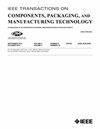Study of Microdirectional Cu–W Contact Separation Stage Based on Multiphysics Coupling
IF 2.3
3区 工程技术
Q2 ENGINEERING, ELECTRICAL & ELECTRONIC
IEEE Transactions on Components, Packaging and Manufacturing Technology
Pub Date : 2024-10-23
DOI:10.1109/TCPMT.2024.3485102
引用次数: 0
Abstract
The failure of welding of contact materials is a key factor restricting the improvement of electrical life and reliability of high-power electric contact switch electrical appliances. To study the melting deformation of microscopic contact area during the formation of contact static fusion welding, a new Cu-W composite contact with a 3-D quadrilateral, hexagonal, and rhombic dodecahedral microdirectional skeleton structure is designed. Based on the theory of fluid dynamics, the dynamic formation process of the molten metal bridge in the contact separation stage is numerically simulated; the temperature distribution, contact resistance size, and shape change of the contact surface are analyzed, and the size of the molten pool formed in the contact separation stage of the studied composites with different skeleton structures is calculated. The results show that the highest temperature of the Cu-W composite contacts with microdirectional skeleton structure occurs in the electrical contact position during the formation of molten metal bridge, among which the contact surface temperature of the composites with the rhombic dodecahedral skeleton structure is the lowest, and the contact resistance, liquid bridge deformation, and molten pool volume are the smallest. Both simulation and experiment show that the micro-oriented W skeleton structure can reduce the contact resistance between contacts, thereby reducing the temperature between contacts, reducing the range of erosion of Cu-W composite material contacts, and enhancing the anti-static welding performance, which has reference significance for the design of low-voltage electrical appliances.基于多物理场耦合的微定向Cu-W接触分离级研究
触点材料焊接失效是制约大功率电触点开关电器电气寿命和可靠性提高的关键因素。为了研究接触静态熔焊成形过程中微观接触区域的熔化变形,设计了一种具有三维四边形、六边形和菱形十二面体微定向骨架结构的新型Cu-W复合触点。基于流体力学理论,对接触分离阶段金属熔桥的动态形成过程进行了数值模拟;分析了不同骨架结构复合材料的温度分布、接触电阻大小和接触面形状变化,计算了不同骨架结构复合材料在接触分离阶段形成的熔池大小。结果表明:微定向骨架结构的Cu-W复合材料触点在熔桥形成过程中的电接触位置温度最高,其中菱形十二面体骨架结构的Cu-W复合材料接触面温度最低,接触电阻、液桥变形和熔池体积最小。仿真和实验均表明,微取向W骨架结构可以减小触点之间的接触电阻,从而降低触点之间的温度,减小Cu-W复合材料触点的侵蚀范围,增强抗静电焊接性能,对低压电器的设计具有参考意义。
本文章由计算机程序翻译,如有差异,请以英文原文为准。
求助全文
约1分钟内获得全文
求助全文
来源期刊

IEEE Transactions on Components, Packaging and Manufacturing Technology
ENGINEERING, MANUFACTURING-ENGINEERING, ELECTRICAL & ELECTRONIC
CiteScore
4.70
自引率
13.60%
发文量
203
审稿时长
3 months
期刊介绍:
IEEE Transactions on Components, Packaging, and Manufacturing Technology publishes research and application articles on modeling, design, building blocks, technical infrastructure, and analysis underpinning electronic, photonic and MEMS packaging, in addition to new developments in passive components, electrical contacts and connectors, thermal management, and device reliability; as well as the manufacture of electronics parts and assemblies, with broad coverage of design, factory modeling, assembly methods, quality, product robustness, and design-for-environment.
 求助内容:
求助内容: 应助结果提醒方式:
应助结果提醒方式:


